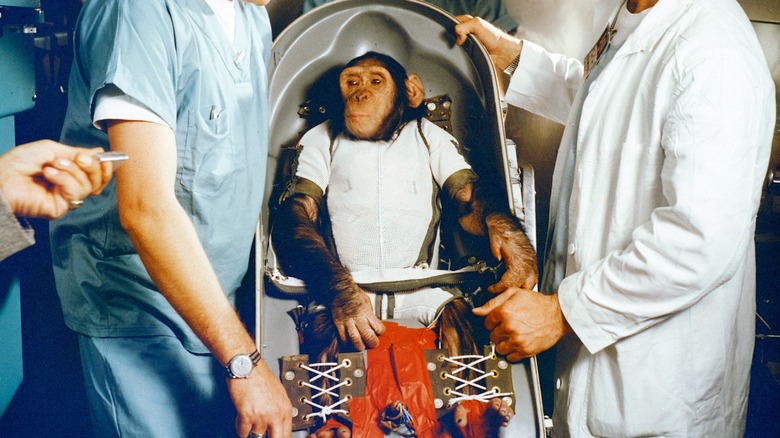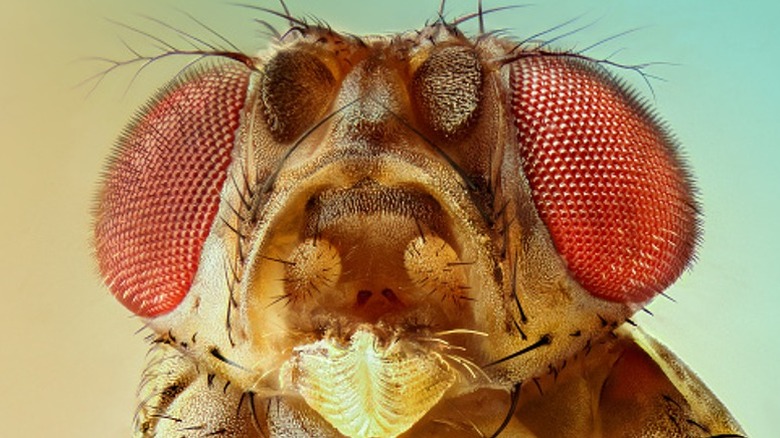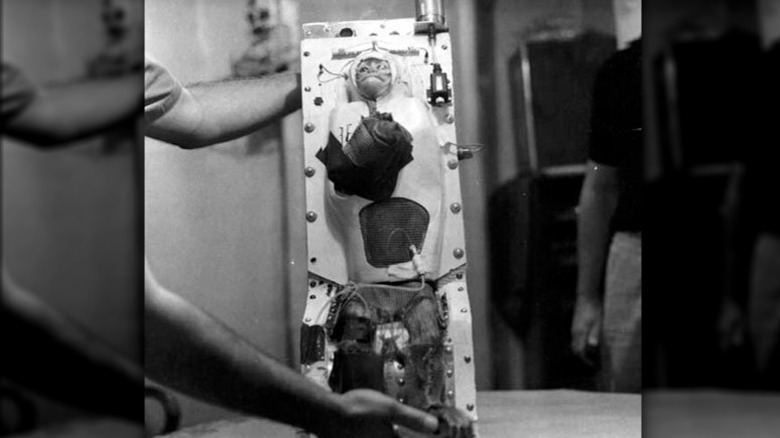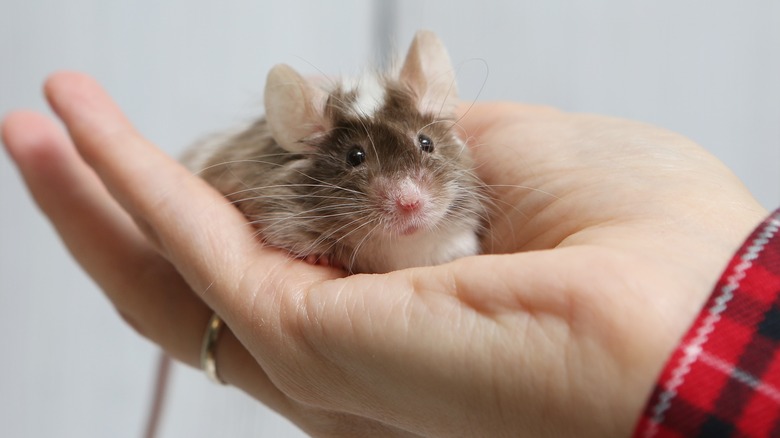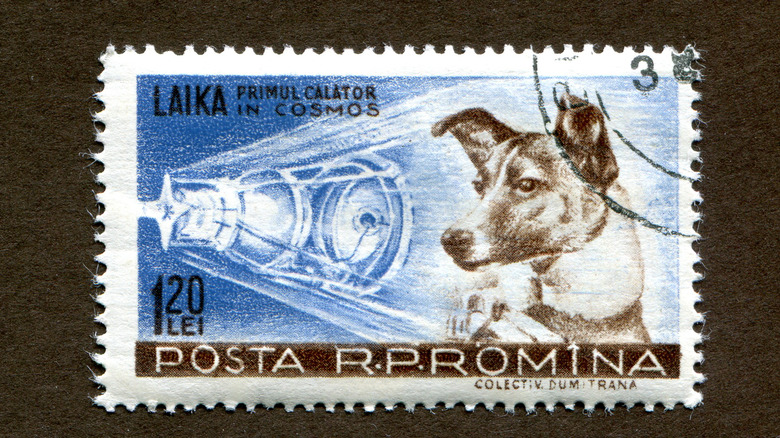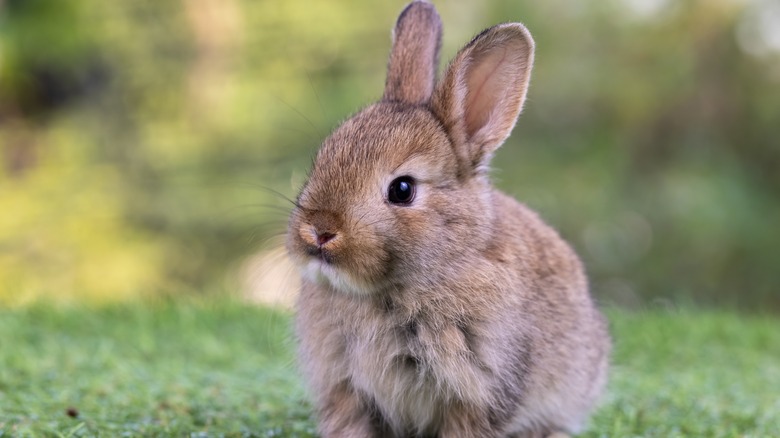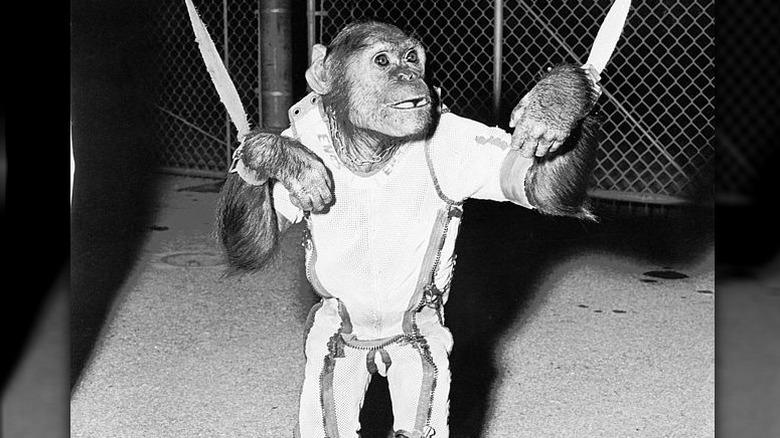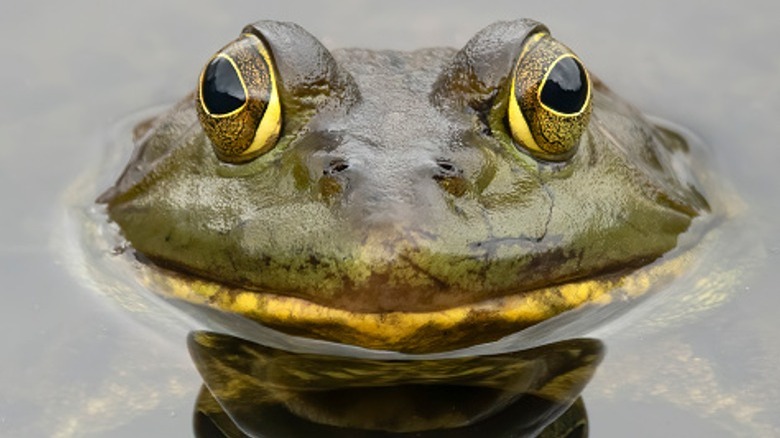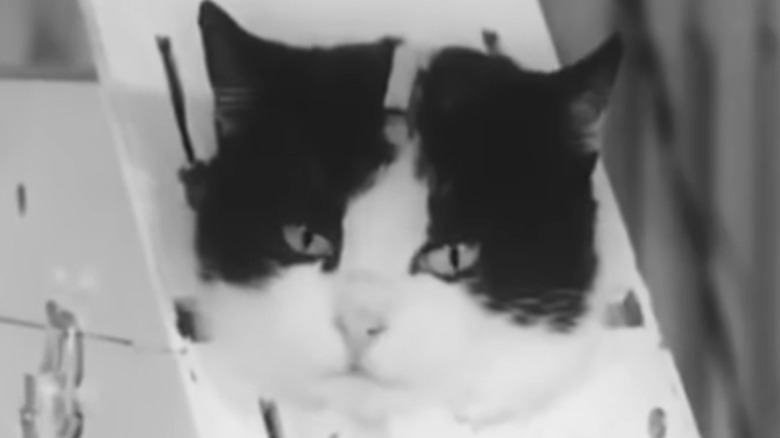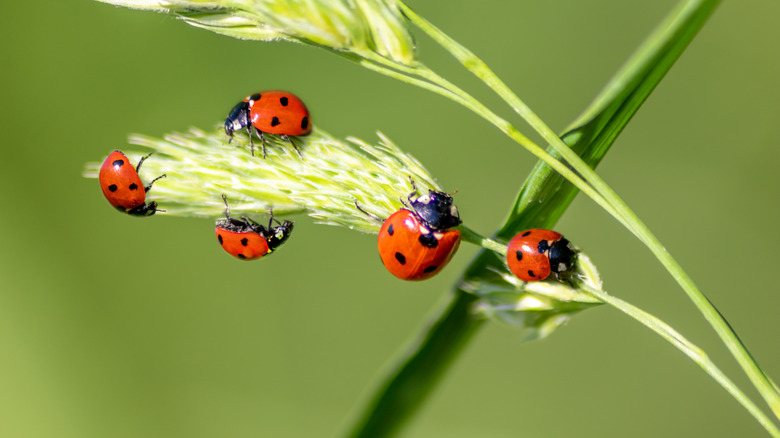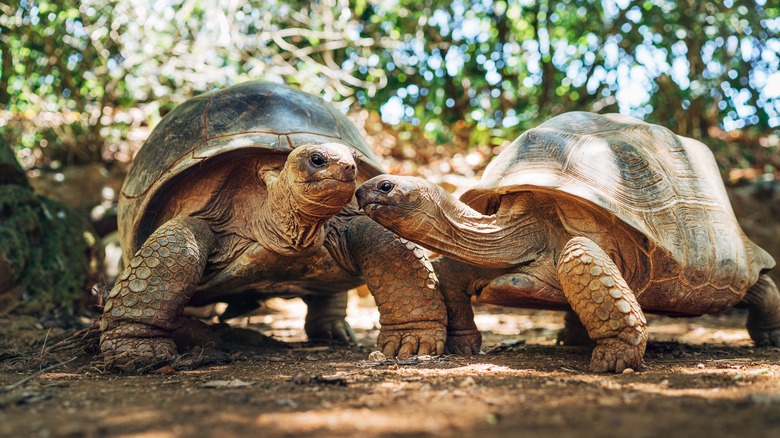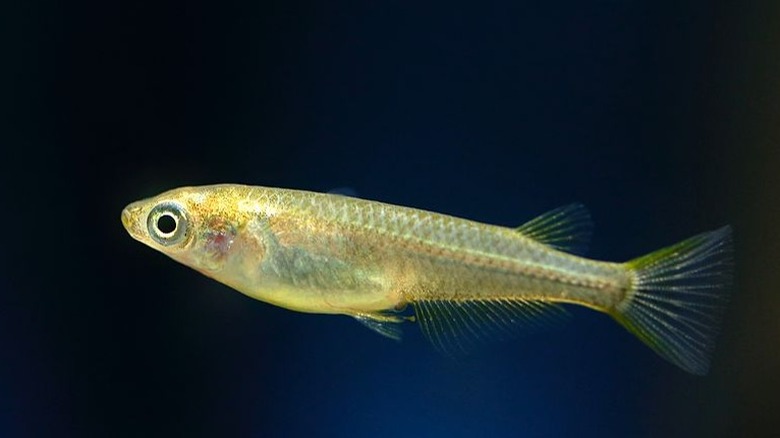Every Animal That Has Been To Space
One small step for man, a bunch of even smaller steps for our animal companions. Before any human ventured into the final frontier, scientists used a variety of creatures to test how treacherous the cosmos were, and you would be surprised by the variety of test subjects in these experiments. From fruit flies to tortoises, monkeys to ladybugs, a plethora of species rather than just humans have gotten to celebrate being an earthling that made it out to space.
Though sadly, many of these animals haven't always survived their journey, it's important to remember the sacrifices that these creatures unknowingly paid to advance future technologies that paved the way for astronauts and cosmonauts to thrive in space. Scientists study how these animals' bodies and DNA were affected by cosmic radiation, zero gravity, and other factors when traversing through the cosmos, giving them more information about making space travel safer. So what animals have been sent to space, and what was their purpose for being launched off the face of the Earth?
Fruit Flies: The First Creatures in Space
The first species humans ever sent to space were fruit flies back in 1947, and they are still studied by NASA and other space agencies today. Scientists like to study fruit flies due to their genetic similarities to humans, and given how small they are, they make for a suitable testing group that can provide insight into the long-term effects that prolonged time in space causes.
Fruit flies first took the voyage into space on the V-2 rockets, which were originally used by the Germans during World War II to attack long-distance targets. After the war ended, many scientists and researchers in the United States used the rockets to study future space infrastructure, with some Nazi scientists coming to work for NASA to further develop this technology. The fruit flies barely made it into space, reaching an altitude of 67 miles above the Earth's surface. For reference, that is only a mile above the recognized starting point of space. After the rocket parachuted back down to Earth, scientists were able to study the effects of radiation, which helped them understand how humans would be affected in space.
Monkey Business
Though fruit flies may have similar biological systems to humans, there are some key differences between them ... shocker right? When studying spaceflight, many monkeys were used by scientists to better understand how the body deals with stress and fluctuating g-forces as you rapidly accelerate out of Earth's atmosphere. By June 14, 1949, NASA was able to launch the first monkey (and mammal), Albert II, into space.
It wasn't exactly a fun trip for the little guy either, and tragically he wouldn't survive the trip due to a parachute malfunction on the descent back to Earth — something that would kill other future monkey astronauts as they were strapped onto rockets and shot up to space. Albert II was launched from the same location the fruit flies were two years prior, White Sands, New Mexico. Albert II was sent into space on the Blossom V-2, a variation of the German V-2 rockets.
Scientists were able to hook multiple sensors up to Albert II's body during his flight, and, although he was anesthetized, the results weren't pleasant, to say the least. Albert II was noticeably very distressed as he quite literally skyrocketed past Earth. A year earlier, scientists had tried to launch Albert II's predecessor, Albert I, but failed when his rocket didn't reach the Karman line, the boundary where space begins. Data collected by scientists suggest Albert I suffocated before his capsule crashed into the Earth. No other Albert survived their flight either, except for Albert VI; however, his craft didn't make it into actual space, and he died shortly after landing.
Cosmic Mice
Mice have been used in numerous scientific experiments, including ones in the cosmos. The first mouse was sent into space in late 1950, but tragically it didn't survive the journey. Unfortunately not much has been recorded about that flight, other then some images of the mouse at zero gravity, but NASA continued to use the tiny mammals in missions. Eight years later, two mice were launched from Cape Canaveral, Florida, where they reached higher than other test animals up to that point. British Pathe even covered the launch of the third mouse to what appeared to be a successful flight. While both mice reentered the Earth's atmosphere successfully, with all signs pointing to recovery, they were lost at sea.
Since then, plenty of mice have been sent to space, where they are still studied by researchers today. One recent study in the in the journal Proceedings of the National Academy of Sciences sent a group of 40 mice to the International Space Station (ISS), and another 24 were kept on Earth as a control group.
NASA researchers were looking to find ways to prevent muscle and skeletal degradation in space, which is quite common in low-gravity spaces. Scientists blocked the experimental group's myostatin and activin pathways, which both limit muscle growth and cause it to degrade over time, to see what would happen to the group's overall muscle mass while aboard the ISS. The researchers found that these mice, nicknamed "mighty mice" because they were genetically enhanced, had more muscle mass than the control group. NASA hopes to use this technology on human astronauts to help prevent muscle loss and skeletal
Space Pups
Man's best friend has also had the luxury to brag about adventuring into space. On July 22, 1951, the first dogs were launched into space by the Soviets, who wanted to study how space would affect humans. Tsygan and Dezikreached an altitude of over 60 miles, effectively putting them just over Earth's boundary into space. Their entire flight lasted all of 15 minutes, and unlike the Alberts, these earthlings did survive their spaceflight, becoming the first mammals to venture into the cosmos and live to tell about it ... well, bark about it, but you get the point.
Perhaps the most well-known pup was Laika, the first dog and mammal to ever be sent into orbit six years after Tsygan and Dezik. Her cabin had been equipped with technology to study cosmic radiation, as well as other harmful factors space might inflict upon the body. Although Laika survived the launch and was equipped with crude food and water, she would die after a few days in Earth's orbit from overheating. Sputnik 2, the spacecraft Laika was on, crashed down to Earth on April 14, 1958, finally bringing Laika's body down to Earth.
The Soviets were eventually able to send dogs into orbit and have them safely land back down on Earth — the first being Belka And Strelka, in 1960, who garnered much fame. They revolved around the Earth 18 times in about 25 hours before touching back down.
Rabbit in Space
Rabbits in space might sound like a silly sci-fi book, or perhaps even a Bugs Bunny cartoon. But these fuzzy friends have also taken their turn in the cosmos. In 1959, the Soviets launched Marfushaon an R2-A rocket with two other canine companions and some mice and insects. Also known as Little Martha, she became the first rabbit to be sent into space and live to tell the tale as well. According to a report by the U.S. Naval School of Aviation Medicine, Soviet press at the time reported that the mission observed the animals' reaction to weightlessness, and that it was pretty monumental, proving that, in bringing animals back alive, humans could survive in space.
The Soviets continued their tests on rabbits. A year later, Belka and Strelka were not alone on their journey into orbit – they were accompanied by a rabbit, as well as a few other species that had already made successful flights. Their ship was called Sputnik 5, and it was also the first time any creature was sent into orbit and survived coming back to Earth. Sadly, none of the other creatures got as much publicity as their canine comrades.
Rabbits have not been a popular test subject to use by scientists in recent times, making Marfusha and the rabbit aboard Sputnik 5 true cosmic oddities.
Space Chimps
Even though monkeys have been sent into space since the late 1940s, the first great ape, primates who are evolutionarily closely related to humans, was launched into space by the U.S. on January 31, 1961. The passenger on board was Ham, a chimpanzee who was from a rainforest in Cameroon. Ham had been taken from his home and was delivered to the United States where he underwent training at Holloman Air Force Base to become an astronaut.
Ham and other chimpanzees underwent extensive training to essentially show the ability to operate equipment during flight, and Ham excelled at this process. Ham's flight flew roughly 156 miles above Earth's surface and lasted about 16 minutes. Researchers remarked that Ham was extremely stressed during the situation, and after his capsule landed in the ocean he was given an apple as a treat. Ham went on to live in a couple of zoos throughout his life before he died at the age of 26 in 1983.
About 11 months after Ham's flight, Enos, another chimp from Cameroon, became the first chimpanzee to enter Earth's orbit, which would've been more impressive if the Soviet Union had not sent the first man around Earth's orbit months earlier. Enos had been in orbit for five hours before descending back to Earth. Enos was then rescued by a few Navy officers. Unfortunately, Enos's journey wasn't highly commemorated, mostly due to the Soviets' achievements being much more newsworthy.
Frogs in Space
Scientists haven't just sent furry creatures to space — amphibians like frogs have also had the privilege of seeing the cosmos firsthand; however, their history as astronauts has been a little messy, to say the least. The first time a frog went to space was in March 1961, when the Soviet Union sent their Vostok M3 rocket into space with Andrian Nikolayev, a Russian cosmonaut, along with a guinea pig and mice.
After this, researchers continued to send frogs to space to study their bodily reactions while off-world. NASA sent frogs into space for this reason in 1970, when two frogs were sent to space on the Orbiting Frog Otolith spacecraft to test how spaceflight effects motions sickness. Frogs' inner ears are similar to human inner ears when it comes to what causes motion sickness. According to Medical News Today, the inner ear is one of a few senses that can be affected by conflicting messages when the body is in motion. Symptoms like nausea occur when it's essentially sensory overload. NASA's frogs — bullfrogs to be exact — were fitted with electrodes to monitor their experience. Results showed that over the course of the six-day flight, the frogs stayed healthy and adapted to their situation.
Scientists have continued to use frogs to study how they adapt to gravity, doing further study on motion sickness, as well as studying their response to external stimulation — all things that are important for any space mission.
The Forgotten Félicette
The U.S. and the Soviet Union are responsible for sending most of the first animals to space on this list, but the first and only cat to be sent into space got her astronaut training done in France. In October 1963, the French government launched a Veronique AG1 rocket with Félicette on it. Archival footage (via the National
Audiovisual Institute) shows the feline hooked up to an electrode to monitor brain activity. According to scientists, Félicette remained perfectly calm during her mission, which reached 100 miles above Earth's surface. The flight was short, and although Félicette returned safe and sound, she never got much credit for representing the feline community in outer space. At the time, the Space Race was largely a fight between the USSR and America, leaving the French as the underdogs.
Many critics have argued that Félicette should be memorialized at the International Space Hall of Fame, since she was the first and only cat successfully launched in space. Other animal astronauts have been memorialized there, including the first chimp who went to space has his bones there. And still others have been memorialized, including Laika. In 2019, Felicette did get her due after a successful Kickstarter campaign raised funds for an official memorial for her at the International Space University in Strasbourg, France.
Bugs in Space
Fruit flies have bragging rights to being the first creatures ever to go into space, but they weren't the only bugs to make the journey. Other insects, such as houseflies, were studied by scientists to see how their flight patterns would change in space. In 1982, NASA chose to study the effects on honeybees, house flies, and moths when in space. When placed in a zero-gravity environment, these critters stopped flying and adapted their movement to the environment. The flies simply crawled, while the moths learned how to use their wings to glide instead of fly. The bees struggled a bit more with more erratic movement.
In 1999, a group of Chilean high school students created an experiment to see how ladybugs would fare with hunting aphids in a zero-gravity environment in order to determine if they would be adequate pest control on space stations. With help from the Chilean Air Force and NASA, the students were able to get their experiment launched on the condition that all information must be shared with scientists back in the U.S.
Tortoises Around the Moon
In May 1961, President John F. Kennedy announced the United States' plan to go to the moon by the end of the decade — a lofty goal, especially from a country that was behind on almost every measure in the Space Race with the USSR. And although Kennedy didn't live to see his vision completed, by July 20, 1969, Apollo 11 landed on the moon with three astronauts: Neil Armstrong, Michael Collins, and Buzz Armstrong. Before this mission, the first humans to orbit the moon were onboard Apollo 8, in December 1968 — but even these individuals weren't the first creatures to make this trip.
On September 18, 1968, the USSR launched their Zond 5 spacecraft carrying two Russian tortoises, worms, flies, and plant seeds to orbit the moon, making these the first lifeforms from Earth to orbit another planetary body. The mission was more of a publicity stunt than anything because at that point the Soviet Union was quickly losing its edge over the U.S.
The tortoises were chosen due to their physiology, as their organs are similar to humans. Plus their hard shells and their ability to go without food and water for long periods made them uniquely suited for the rigors of spaceflight. As the tortoises re-entered the Earth's atmosphere, they hit G-forces that would kill a human. They were later studied, with results showing that they lost a little weight and their livers changed color — but they were otherwise in good health.
Fish in the Cosmic Sea
There are plenty of fish in the sea and apparently in space as well. Since 1973, scientists have been studying how fish survive off-Earth, and they've used a variety of different species for research purposes. The first fish that was sent into space was the mummichog, which is native to the eastern coast of North America. Sent to the Skylab space station, these fish demonstrated their ability to still swim while weightless. A study in Aviation Space and Environmental Medicine reported that it took the fish about three days to adapt and swim normally.
Since then, numerous species of fish have been sent to the cosmos. In 2010, NASA studied how a toadfish's inner ear was affected in a zero-gravity environment, something that helped scientists better understand how creatures adapt to disorienting surroundings.
A research group based in Tokyo conducted a study in 2014 on a group of medaka fish to study how microgravity affects gene expression, specifically for osteoblasts and osteoclasts, cells that help form bones (via Scientific Reports). Scientists examined the change by observing the fluctuation in fluorescent protein the medaka fish produced while in space. What they found was that there was a significant difference, but sadly most of the fish did not survive their time in space.
[Featured image by Kotaro Negawa via Wikimedia Commons | Cropped and scaled | CC BY-SA 4.0]
